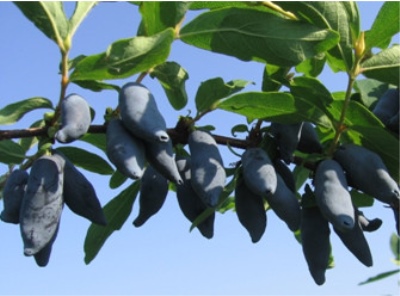
- Authors: A.T. Tkacheva, I.K. Gidzyuk, N.V. Savinkova, N.M. Bochkarnikova (Bakchar stronghold of northern gardening)
- Appeared when crossing: from free pollination of selected form 68-2 of Turchaninov's honeysuckle
- Year of approval: 2000
- Growth type: medium-sized
- Description of the bush: medium density, compact
- Bush height, m: 1,5
- Escapes: straight, medium, pubescent, with a hanging top, green, with a slight anthocyanin tan on the sunny side
- Leaves: elliptical, medium, green, pubescent on both sides
- Transportability: good
- Crown: round, thick
The popular berry culture, honeysuckle, is easy to grow even in adverse weather conditions. The main thing is to choose a variety that quickly adapts to the climate, bears fruit stably and is rarely affected by fungi. These include the edible Narym honeysuckle.
Breeding history
Honeysuckle Narymskaya is a representative of the Bakchar selection, created at the stronghold of northern horticulture in 1992. The authors of the variety are breeders A.T. Tkacheva, N.V. Savinkova, I.K. Gidzyuk. A culture was brought out by free pollination of the following type of honeysuckle - Turchaninov (form 68-2). Enriched the State Register of approved varieties Narymskaya in 2000. The most productive edible honeysuckle, growing in the East Siberian and West Siberian regions.
Description of the variety
Early honeysuckle is a medium-sized shrub with a round or hemispherical crown with medium thickening of elliptical bright green leaves and strong branching, which is formed by reddish-brown branches. A characteristic feature of the shrub is the arched shape of the branches. In a favorable environment, the height of the honeysuckle bush reaches 150-170 cm.
The culture blooms in May, for several weeks. At this time, the compact crown of the bush is covered with not very large flowers of a pale yellow color, which attract with a sweetish aroma.
Fruit characteristics
Narym honeysuckle is a large-fruited variety. Berries grow on bushes weighing 0.9-1.5 g. Fruit shape is elongated-oval, sometimes pod-shaped. Ripe honeysuckle is covered with a dark purple color, diluted with a thick gray bloom, reminiscent of waxy. The peel of the berries is dense, but not tough, with a noticeable tuberosity. The berries are firmly attached to the shortened stalks, while the separation from the fruits is dry. Ripe berries do not crumble.
The advantage of the variety is the sufficient keeping quality of the berries - 2-3 days under normal conditions, up to 5-7 days in the refrigerator. Honeysuckle tolerates transportation well, since the berries are protected from deformation by a dense skin.
The purpose of this type of honeysuckle is universal - they are eaten fresh, frozen, processed into jams, fruit drinks, drinks.
Taste qualities
Narymskaya is famous for its excellent taste. The flesh of the fruit is fleshy, dense, juicy. The taste is sweet and sour, perfectly combined with a pleasant, but not pronounced aroma. The pulp has no sweetness and bitterness. Honeysuckle pulp is rich in vitamins and minerals, and it also contains more than 7% sugars and 2.1% acids.
Ripening and fruiting
The variety is early maturing. The shrub begins to yield the harvest from the second year after planting.The berries ripen gradually, since the bush is quite dense, so there may be several stages of harvesting. You can taste the taste of Narym honeysuckle in mid-June. Mass ripening and fruiting begins at the end of June and lasts 2-3 weeks. The bush bears fruit for 20-25 years.
Yield
The variety has high yields. With good agricultural technology and a favorable climate, one adult 6-7 year old shrub will yield 2.5-4 kg of useful berries. Agrarians collect an average of 73.3 centners of fruits per hectare of plantations.

Self-fertility and the need for pollinators
Honeysuckle is self-fertile, so additional cross-pollination is required to obtain good yields. For this, varieties of edible honeysuckle with similar flowering periods are suitable, for example, Vasyugan, Tomichka, Bakcharskaya. In addition, bumblebees are important pollinators, as there are no bees at the time of early flowering.
Growing and care
Planting of two-year-old seedlings is carried out in the fall (late September - early October). To do this, choose a flat area, protected from strong winds and drafts. The distance between bushes should be at least 1.5 meters.
The agricultural technology of the culture is very simple: watering, application of fertilizing from 3 years of growth, loosening and weeding of the soil, sanitary pruning of branches, prevention of diseases. The bush does not need to form the crown.


Disease and pest resistance
Good immunity protects the berry crop from most diseases, as well as from attacks of insect pests (aphids, scale insects, spider mites). It is extremely rare that shrubs are affected by powdery mildew and cercospora.

Winter hardiness and the need for shelter
The variety is frost-resistant, withstanding temperature drops of up to -30 degrees. The bushes do not need shelter for the winter; rather intensive feeding, moistening and mulching of the near-root area.
Location and soil requirements
Narymskaya loves the sun, light, space and moderate moisture, therefore it is comfortable to grow in nutritious, fluffy, breathable, moisture-permeable, with neutral acidity, soils. It is important that the flow of groundwater is deep, otherwise excess moisture can cause rotting of the roots and contribute to the appearance of fungal diseases.
































































